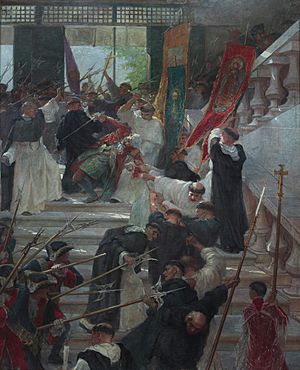Félix Resurrección Hidalgo facts for kids
Quick facts for kids
Félix Resurrección Hidalgo
|
|
|---|---|

Self Portrait (1901), Private collection of Tony and Cecile Gutiérrez, Makati City.
|
|
| Born |
Félix Resurrección Hidalgo y Padilla
February 21, 1855 |
| Died | March 13, 1913 (aged 58) |
| Resting place | Cementerio del Norte, Manila |
| Nationality | Filipino |
| Known for | Painting, drawing |
|
Notable work
|
Las Virgenes Cristianas Expuestas al Populacho, 1884,
La barca de Aqueronte, 1887 in museums:
|
| Movement | Impressionism, Neoclassicism |
Félix Resurrección Hidalgo y Padilla (born February 21, 1855 – died March 13, 1913) was a famous Filipino artist. He is known as one of the greatest Filipino painters of the late 1800s.
Hidalgo was important in Philippine history because he knew and inspired members of the Philippine reform movement. This group included important figures like José Rizal, Marcelo del Pilar, and Graciano López Jaena. Even though he was friends with them, Hidalgo did not directly join their political movement.
In 1884, Hidalgo won a silver medal at the Madrid Exposition of Fine Arts. Another Filipino painter, Juan Luna, won a gold medal at the same event. This was a huge moment for Filipinos. It led to a big celebration where José Rizal praised both painters. He said their wins proved that Filipinos and Spaniards were equal in talent.

Early Life and Learning
Félix Resurrección Hidalgo was born in Binondo, Manila on February 21, 1855. He was the third of seven children in his family. His parents were Eduardo Resurrección Hidalgo and María Bárbara Padilla.
He started studying law at the University of Santo Tomas. However, he never finished his law degree. Instead, he was very interested in art. In 1879, he moved to Europe to study art. He received a scholarship from the Spanish government. He studied at the Real Academia de Bellas Artes de San Fernando in Madrid until 1881. He also learned from the Spanish painter Agustin Saez.
Before going to Europe, Hidalgo already showed his talent. In 1876, he displayed his paintings La barca and Vendedora de lanzones. These works were shown at the Teatro Circo de Bilibid. Later that year, they were sent to the Centennial Exposition in Philadelphia, Pennsylvania. In 1878, he painted Los mendigos.
Life as an Artist Abroad
In 1877, Hidalgo won second place in a competition. He designed the cover for a special book called Flora de Filipinas. In 1879, he left for Spain to continue his art studies. He was supported by the city government of Manila.
One of his most famous paintings is Las Virgenes Cristianas Expuestas al Populacho. This painting won a silver medal in 1884. It was shown at the Exposición General de Bellas Artes in Madrid. The painting shows Christian women being mocked by a group of men. In the same show, Juan Luna won a gold medal for his painting Spoliarium.
Hidalgo continued to win awards. In 1887, he showed La barca de Aqueronte and Laguna estigia. These paintings earned him a gold medal in Madrid. La barca was shown again in Paris in 1889. There, it won a silver medal from an international group of judges. In 1891, it received a special award in Barcelona. This painting also won a gold medal in Madrid. This was during a celebration of the 400th anniversary of the discovery of the Americas.
Hidalgo showed his art in many places. He exhibited Adios del Sol in Madrid in 1891. His painting El crepusculo was shown at the Universal Exposition in Chicago. Both paintings were also displayed in Bilbao in 1894. In 1895, he showed several paintings in Paris. These included Oedipus y Antigone and El violinista.
In 1904, Hidalgo received a gold medal for all his works. This was at the Universal Exposition in St. Louis, Missouri. His painting El violinista also won a gold medal on its own.
In 1912, he visited his family in Manila for six months. He then quickly returned to Paris to see his mother, who was very ill. The next year, Félix Resurrección Hidalgo passed away in Barcelona. He had gone there to get better from his failing health. His body was brought back to the Philippines. He is now buried at the Cementerio del Norte in Manila.
Famous Artworks
Here are some of Félix Resurrección Hidalgo's well-known paintings:
- La barca, 1876
- Vendedora de lanzones, 1876
- Las Virgenes Cristianas Expuestas al Populacho, 1884
- The Young Woman Sewing, 1885
- Jesucristo, 1887
- La barca de Aqueronte, 1887
- La Laguna Estigia, 1887
- La Pintura, (around 1890s)
- Adios del Sol, 1891
- El crepusculo, 1893
- Oedipus y Antigone, 1895
- El violinista, 1895
- Self portrait, 1901
- Per Pacem et Libertatem, 1903
His Legacy
Félix Resurrección Hidalgo left a lasting mark on Filipino art. In 1988, his works were shown alongside those of his friend Juan Luna. This special art show was called the First National Juan Luna and Félix Resurrección Hidalgo Commemorative Exhibition. It took place at the Metropolitan Museum of Manila. The exhibition featured many of their paintings from different collections.
See also
 In Spanish: Félix Resurrección Hidalgo para niños
In Spanish: Félix Resurrección Hidalgo para niños
- Antonio Luna
- Juan Luna
- José Rizal
- José Honorato Lozano
- Damián Domingo
- Fernando Amorsolo
- Fabián de la Rosa
- Justiniano Asunción

